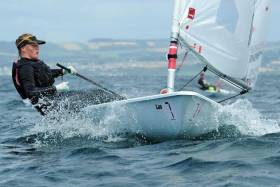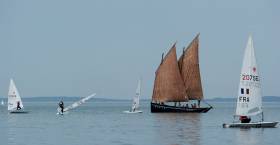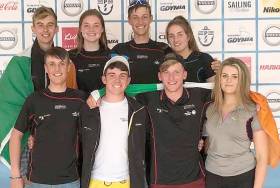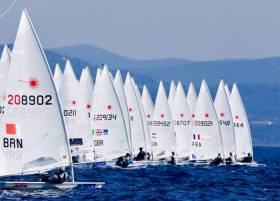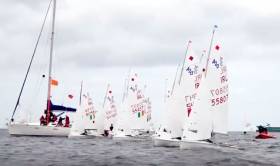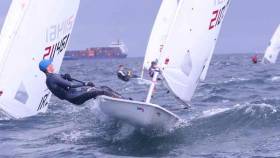Displaying items by tag: Radial
Lough Derg Yacht Club's Aisling Keller took seventh place overall at the under–21 Laser Radial World Championships closely followed by Irish team mate Aoife Hopkins of Howth YC in ninth place overall.
The encouraging results achieved at the Nieuwpoort, Belgium venue from 26 July – 2 August followed Euro title success in this age category for Hopkins the preceding week in Douarnenez, France. That was a result that earned the Howth youth sailor an Afloat Sailor of the Month Award.
The calendar is now so packed it's no longer possible to attend all the events. For example, Hopkins had turned down her invite from World Sailing to attend the Aarhus Test Event as three events in a row are too much. Instead it's a well deserved recovery period.
Results from Belgium are here
When that definitive image of young Aoife Hopkins leppin’ her Laser with rocket power out of a breaking wave at the European Women’s Laser Radials Under 21 Championship 2017 (July 17th to 24th) at Douarnenez in Brittany went viral, we all knew something very special was going on.
But though the young Howth sailor clearly revelled in the heavy going, she proved well able for conditions of all sorts, and had the mental strength to withstand an entire crucial day lost to calm. With three races packed into the final day, she took three firsts to clinch the trophy by a country mile.
An outstanding Sailor of the Month for July among our potential Olympians.
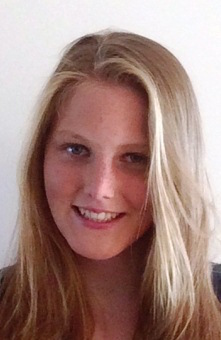 Aoife Hopkins
Aoife Hopkins
Clean Sweep for Ireland in Laser Radial Under-21 Women Euros
With a first overall for Aoife Hopkins of Howth, a second overall for Aisling Keller of Lough Derg, and a seventh overall for Sally Bell from Belfast Lough, Ireland has made pretty much of a clean sweep of the Laser Radial Under-21 Women’s Euros in Douarnenez writes W M Nixon.
Hopkins won it, with a trio of wins in yesterday’s packed schedule, and she comes home with just 10 points against her, having discarded a 3rd and a 4th to give her a scoreline of seven wins and a third.
Keller had a second and two thirds today, while Bell had a BFD, a sixth and eighth. With all of yesterday’s racing lost in a damp calm, it was a tense final day. But in a series which has seen everything from no wind at all up to the very edge of sailability with people racing among Atlantic breakers, it has ended on a real high for the Irish squad.
Just like their junior Laser counterparts at the 4.7 Worlds in Belgium this week, Irish girls are off to a flying start at the Laser Radial Under–21 Women European Championships in Douarnenez, France. Ireland holds the top three places after the first two races in the 17–boat affair.
Howth Yacht Club's Olympic trialist Aoife Hopkins is a single point off the lead on four points. She leads Royal North's Sally Bell who Afloat.ie readers will recall posted a top ten result last week at the Radial Youth Euros in Poland. Bell is on ten points in third place with Lough Derg's Aisling Keller fourth on 12–points.
In the boys Laser division at Douarnenez, Liam Glynn from Ballyholme Yacht Club is 39th from 70.
Find the overall results here.
The next wave of Irish Laser Olympic prospects were out in force at the Radial Youth Sailing European Championships from 6th–13th July in Gdynia Poland.
Conditions were light for most of the event with strong winds on the last day.
In the boys fleet, Irish youth champion Ewan McMahon of Howth Yacht Club showed a consistent performance to finish eighth in the Gold fleet. Royal Cork's Johnny Durcan was 17th with the National Yacht Club's Loghlen Rikard 24th. Conor Quinn of Rush SC was an individual race winner and finished 31st. MacMahon's younger brother Jamie was 41st and seventh in the U17 category.
 Ireland's next generation of Olympic sailors were out in force in Poland. Ewan McMahon and Sally Bell finished 8th and 10th in boys and girls respectively at the Laser Radial Youth Europeans in Poland. Photo: ISA
Ireland's next generation of Olympic sailors were out in force in Poland. Ewan McMahon and Sally Bell finished 8th and 10th in boys and girls respectively at the Laser Radial Youth Europeans in Poland. Photo: ISA
Fionn Conway and Peter Fagan were 50th & 51st and Henry Higgins was 60th in Gold fleet.
Peter Gilmore, Andrew Mitchel and Hugo Moran were Silver and Bronze fleet finishers.
Three Irish girls competed at the event for the first time. Sally Bell of the Royal North Ireland YC was a top finisher in tenth overall in the girls division.
Nell Staunton of the National YC, who has just returned to sailing after a foot injury, finished 16th.
Tara Coveney RCYC/RSt George put in a really strong challenge but was unfortunate to break her tiller extension on one day finished 46th and 10th in the U17 division.
A link to the event website results section is here
Additional report from Irish coach Russell McGovern:
The Irish Laser youth academy travelled out to Poland at the start of July for final preparations for competing at the Youth European Championships.
The team was Sally Bell, Nell Staunton, Tara Coveney, Ewan McMahon, Jamie McMahon, Johnny Durcan, Loghlen Rickard.
The squad had been sailing full time from the end of May and were in good spirits. We had been using the Royal Irish Yacht Club as our base and sailing 5 to 6 days a week with a tough physical program too.
They had done a warm up regatta in early June in Hoorn and had won that but also high lighted some areas to work on which was the reason for attending, so going to Gdynia they knew they in good shape.
The venue was always going to be difficult to get consistent racing in due to the synoptic situation that is common in that part of the Baltic in the summer, and to Quote the RO
“this place in bonkers”. However, he did manage to get 10 races in over the 6 days of racing.
The first day was a 10 hour day on the water with 2 races cancelled and re run, and some awesome thunder storms and this was to be the trend until the last day. It was a difficult race course to manage with 70 degree wind shifts, light breeze and 4 fleets of 60 boats, however the team put in some solid results and sailed with a very positive and level approach just as they would in training.
After the 3rd day the Girls where in a strong position sitting just outside the the top 10 and the boys where now to be split into finals which they all made gold fleet, Ewan and Loghlen in the top 10 and Jamie and Johnny with in touch of top 20.
The first day of Finals saw the boys and Girls have there toughest day of the entire regatta where they were in the top group and in both races saw the fleet change on the 2nd upwind with a 90 degree wind change, and with such slow boat speeds it was nearly impossible to chase over to catch the change once spotted.
The last day we woke to an 18-22 kt northerly breeze with short steep waves, and this saw the team dominate the day and to open things saw Sally score a 1 and 5.
Nell who has just come back from injury scored a 5 and 8 and Tara who is the newest member of the squad lead the first race of the day and went on to score a 14 and 7.
While on the gold fleet boys it was something similar with Ewan scoring a 1-6 and Johnny scoring 2-1 with the other lads right up there but having a few spills pushing it hard down wind.
All in all it was a great event and highlighted some areas to work on in prep for the worlds in August in the Netherlands.
If these young sailors stay in the sport and keep progressing at the current rate of knots the future will surely be bright for Irish Sailing.
Lynch, McMahon & Higgins Crowned Ulster Laser Champions at Royal North of Ireland Yacht Club
Ireland's youngest ever Olympic helmsman won three of six races to be crowned Ulster Laser Champion yesterday at Royal North of Ireland. Finn Lynch, of the National Yacht Club, had a four point margin with six top three results but was chased hard by Ballyholme's Liam Glynn, who also had a consistent score sheet with five results in the top three to finish on 11 points. Kinsale Yacht Club's Darragh O'Sullivan was one point back to take third in the 13–boat fleet. Both Lynch and Glynn are on the Tokyo 2020 campaign trail, and benefited from a week of competition at the Sailing World Cup in Hyeres immediately before the Ulster event.
Full results in each division are downloadable below.
The breeze on Belfast Lough held very well over the weekend despite fears to the contrary. At eight to 13 knots, a mainly easterly wind had predictable shifts with a short and choppy sea for the combined turnout of 116–boats in three divisions.
As Afloat.ie reported earlier, there were not many surprises in the six–race Radial division with Howth's Ewan McMahon staying top of the 32–boat fleet. Wexford Boat Club's Ronan Wallace was second with Aoife Hopkins of Howth Yacht Club third. A visting Norwegian girl Elnan Flotoft finished sixth.
Royal St. George's Tom Higgins was very quick in the 4.7 division with a scoresheet resembling Finn Lynch's. Higgins, a past UK and Irish Optimist Champion, had three race wins to be seven points clear of club mate Jack Fahy. Kinsale's Michael Caroll was third in the 24–boat fleet.
Mid Fleet Results for Irish Laser Sailors in Hyeres, Stronger Winds Expected Tomorrow for Sailing World Cup
Three Irish Laser sailors are in the middle of the fleet as round two of the 2017 World Cup Series in Hyères, France began today for 541 sailors in ten Olympic classes writes Nathaniel Ogden.
After “one good race and one bad race” for the National Yacht Club's Finn Lynch, he currently holds 31st position, from a total of 60 boats, in the men’s Laser fleet. Another young sailor with Tokyo 2020 in her sights is Howth Yacht Club's Aoife Hopkins, who finished her first day’s racing in 37th place in the women’s Laser Radial class, narrowly beating fellow Irishwoman, Lough Derg Yacht Club's Aisling Keller in 38th position.
The first day of racing began with a light 6-10 knot easterly breeze, allowing the various fleets to get into their stride before the stronger winds, which are forecast for tomorrow, fill in on day two.
In the women’s 49erFX class, Dublin’s Saskia Tidey ended her first day’s racing for Team GBR in an impressive 5th place with helm Charlotte Dobson. Saskia began training with the GBR squad after her Irish helm, Andrea Brewster, announced she was to become an international Olympic coach. Having only made the decision to aim to represent Britain together in Tokyo at the beginning of this year, the duo are wasting no time in getting up to speed in the international fleet.Events cannot be won on the first day in sailing but they can certainly be lost. So, in a stable 8-11 knot south easterly breeze, it was vital that those aiming for the top honours laid down a marker with consistent race results.
In the 38 strong Women's Windsurfer fleet, Israel's Noga Geller came out flying with superb starts and speed. Feeling comfortable in the conditions, she snapped up the first two race wins. "It was between 10-12 knots and good for planing downwind. The conditions were just like home for me so these are my favourite conditions,” Geller explained on her secret to success.
"I was a bit nervous before but winning the first race is always nice and then winning the second was great.”
Having won the first two races in the RS:X fleet, Geller was aiming for a perfect day but a bad start in the third bout of the day meant she was unable to assert herself as she had been doing.
Geller finished in 22nd place, quite the comedown from her flying start. So what happened? "I didn't start well,” said the Israeli, simply. "I was on the wrong side and then I couldn't catch up so it was a really average race for me.
"In these conditions it's that simple. If you don't start well and you don't have a free line then you can't get your speed. It's so important to get a good start.”
She concluded with a smile, "You can't have everything.”
Geller discards her 22nd and leads the way on two points. Zofia Noceti-Klepacka (POL) and Veronica Fanciulli (ITA) follow. The day's other race win went the way of China's Yunxiu Lu, winner at the World Cup Series in Miami, USA.
In the Men's RS:X, Switzerland's Mateo Sanz Lanz had a wonderfully consistent day, winning two races that were sandwiched with a fourth. Like Geller, he put the key to success on the day down to a good start, "As soon as you get clean wind you can get free and choose whichever side you want,” he explained. "It's the one thing that makes a huge difference to where you finish.
"I'm happy as it was a tough day of pumping all the time in gusty conditions. But I managed to start with clean wind and sailed fast.”
South American sailors occupy the top two places in the 49erFX.
Rio 2016 Olympic champions Martine Grael and Kahena Kunze (BRA) lead on three points and Victoria Travascio and Maria Branz (ARG) follow on four.
The Brazilians are the ones to beat in the 49erFX having added Miami gold to their collection after Rio 2016. They got off to the best start in the 20-boat 49erFX fleet, collecting a 1-2-(4) scoreline.
Travascio and Branz were hot on the heels of the Brazilians on day one, finishing third in the opening bout and backing it up with a race win immediately after. They finished the day with a discarded 12th but are pleased to be on the tails of the Olympic champions, "It was really windy and wavy today but it was good,” expressed Travascio.
"I'm happy we got off to a good start. We had two good races but then a bad third race. We went to the right when we really should have gone to the left. Overall we are happy though.”
There were some mixed scorelines in the 49er pack but it's another South American contingent who lead the way. Brothers Yago and Klaus Lange from Argentina top the leaderboard on three points and World Cup Miami winners Dylan Fletcher-Scott and Stu Bithell (GBR) follow one point behind.
Pavlos Kontides (CYP) came out firing in the 60-boat Laser fleet, winning both of the days races. Good boat speed and positioning at the startline enabled Kontides to be within the leading positions at the top mark in both races. From there he was able to use his speed to take a lead at the first gate, in both races, and subsequently he dominated from there.
Nick Thompson (GBR) and Rio 2016 Olympic Champion Tom Burton (AUS) kept Kontides in sight in both races. Thompson picked up a 3-2 and Burton a 4-5.
In the Laser Radial, Evi Van Acker (BEL) posted two strong results as she bids to defend her Hyères crown. A third and a first gives her an eight point advantage over Viktorija Andrulyte (LTU). World Cup Miami winner Vasileia Karachaliou (GRE) had a mixed day with a 35th and fourth. Sailors' worst races will be discarded after the third race so a good performance on Wednesday will propel the Greek racer up the leaderboard.
2.4 Norlin OD Paralympic Champion Damien Seguin (FRA) got off to a flyer in the 12-boat fleet. Seguin posted double bullets and has an early four-point advantage over compatriot Xavier Dagault and Italy's Antonio Squizzato.
Seguin has thrived in Hyères throughout his sailing career, winning gold six times. Winning a record seventh title will set the French racer up nicely for the upcoming Para World Sailing Championships in Kiel, Germany where he will be aiming for a fifth world title.
Moana Vaireaux and Manon Audinet (FRA) controlled the Nacra 17, picking up a (4)-1-2 scorecard to lead on three points. Lin Ea Cenholt and Christian Peter Lubeck (DEN) and defending champions Fernando Echavarri and Tara Pacheco (ESP) follow on six points.
In their first regatta together, Billy Besson, the four time Nacra 17 World Champion, and new crew Amelie Riou got off to a slow start with an 18th and 11th. By the third race, the pair were flying and took the race win.
Great Britain's Ben Cornish and France's Fabian Pic shared the race wins in the 34-boat Finn fleet. Cornish holds an early lead after he backed his race win up with a sixth and Pic sits in fourth after an 11th.
French racers Nicolas Parlier and Axel Mazella dominated their respective blue and yellow fleets in the Foiling Formula Kiteboarding. The pair won every single race, beating World Champion racers Maxime Nocher (MON) and Florian Gruber (GER) respectively.
In the 470 fleets, Rio 2016 bronze medallists Panagiotis Mantis and Pavlos Kagialis (GRE) lead the men's division and Switzerland's Linda Fahrni and Maja Siegenthaler are in control in the women's after two races each.
Racing continues on Wednesday 26 April at 11:00 local time. Live Medal Races will be shown on the World Sailing YouTube Channel on Saturday 29 and Sunday 30 April, bringing the penultimate event before the Santander Final to a close.
ISA Youth Sailing Video from Ballyholme YC Here
Ballyholme Yacht Club has released a video of all the weekend action from Bangor Bay, the largest entry ever for the ISA youth national championships.
Read our full report here and see the latest video moments below:
One of the most notable aspects of the ISA Youth Pathway National Championship 2017, which has concluded this afternoon at Ballyholme on Belfast Lough with a good programme sailed, is the healthy way in which the new champions come from a wide range of clubs and sailing locations writes W M Nixon.
Admittedly, as the rising stars become more established as front runners, we find that bigger clubs at the main centres will make every effort to recruit this fresh talent onto their strength. Nevertheless with crews from as far away as Crookhaven Harbour, Dingle and Tralee Bay making their way up the long road to Ballyholme (and if you’re coming from Dingle, it is one very long road), there’s no escaping the feeling that the Annalise Effect is working. Irish junior sailing is not just undergoing a renaissance. It is putting out energetic new shoots in places where it was relatively dormant before, and the future looks rosy.
Prospects for today’s last races weren’t looking too good on some forecasts, with the lack of wind that bedevilled some of Saturday’s racing looking like persisting. But bang on cue a nice southwest to west breeze settled in on most of the sailing areas, and the fleets went at it as if they’d had no sailing at all until then, with the Optimist class particularly requesting that if at all possible they’d like three races.
 "The bringer of sunshine”. After a championship of mostly grey weather, the sun came out when ISA star coach Rory Fitzpatrick took ISA President Jack Roy out for a spin around the three course areas.
"The bringer of sunshine”. After a championship of mostly grey weather, the sun came out when ISA star coach Rory Fitzpatrick took ISA President Jack Roy out for a spin around the three course areas.
That was a tall order with the last starting sequence required to be no later than 1300hrs. But with very efficient turn-rounds after each race, the thing was done and the series was completed with that wonderful feeling of a good regatta accomplished, which is a whole world away from the default position of “Well, we got a result....”
As for the final results, in the end there were no surprises from the overnight positions. But while some leaders may now look to have been securely in place for some time, in most classes they had to keep working at it until the very end.
In terms of sheer scale of win, the star of the show has to be Justin Lucas (13), who gives his clubs as both Royal Cork and Tralee Bay, so you can guess his career trajectory. In a fleet of 62, after thirteen races he was discarding a 12th and an 11th, leaving a scoreline of 1,1,4,5,1,2,3,5,1,1,4 and a total only 28 points against the 72 of next-in-line Conor Gorman of the National YC.
Third place kept up the pace for remote clubs, as it was won by Harry Twomey of Crookhaven Harbur, then the next two slots were filled by the leading 12-year-old juniors, Johnny Flynn and Luke Turvey, who are both members of Howth, but they also give allegiance to Royal St George and National respectively.
Top girl sailor was Emily Riordan of Royal St George, she was 8th overall on 98 points, second girl was clubmate Alana Coakley at 11th while the National’s Leah Rickard was third at 12th overall.
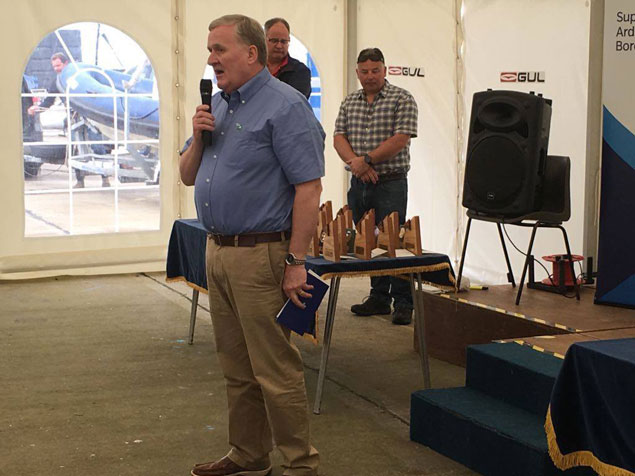 ISA President Jack Roy speaking at the awards ceremony at Ballyholme after the biggest ISA Youth Pathway Championship ever staged, with 208 registered sailors all under the age of 19 (and many very much younger) taking part.
ISA President Jack Roy speaking at the awards ceremony at Ballyholme after the biggest ISA Youth Pathway Championship ever staged, with 208 registered sailors all under the age of 19 (and many very much younger) taking part.
The little ’uns in the Optimists may have served up the numbers and an overall winner with a stratospheric lead, but inevitably the glamour class was the Laser Radials which had gone into Saturday night with Silver Medallist Ewan McMahon’s lead somehow looking vulnerable as he closed with an 11th while Cork’s Johnny Durcan, after a winter spent Laser racing in Australia, was coming on by leaps and bounds.
However, any evidence of super-kangaroo abilities were in short supply for the Durcan camp today, for although McMahon still looked off the pace with a 14th in the first race, Durcan was DNF, and when that was added to a BFD in Saturdays first race, his challenge was effectively over, and in the end he was 9th overall.
So McMahon’s 9th in the final race was enough to retain his lead with a final points total of 41. But all the excitement in the Laser Radials was elsewhere, as the talk today has been of the huge rush of Rush. Aaron Rogers of Rush Sailing Club was in fact the initial overall leader, but today it was clubmate Conor Quinn (who also lists Carlingford Lough YC as his affiliation) who set the pace, with an 8th and then a first to move into second overall, while Rogers took third overall by round the series with a 7th and a 13th.
For quite a few years, the population of Fingal aka North County Dublin was the fastest growing in Ireland, so it was only a matter of time before the new demographic began to show in the national junior sailing results. However, the smart money might have been on Skerries Sailing Club to lead the way, and for a while they did so. But now Rush Sailing Club is showing itself the pace-setter inshore at junior level as seen at Ballyholme, and offshore with the Kelly family in their all-conquering J/109 Storm.
But if you looked solely at club affiliation as an indicator of what’s going on where, the 33-strong Laser 4.7 fleet at Ballyholme would only have lead to confusion, as 2017’s overall winner Jack Fahy lists his clubs as Royal St George, Royal Cork, and Lough Derg. Presumably he has club subscriptions at the top of his preferred Christmas gift list.......
Be that as it may, his scoreline of 6,1,2,1,2,5 discarding his final 8th provides something for everyone. That said, Caoimhe Foster of Royal Cork came on very well at the end, starting with a discarded 11th but recording three straight wins on the trot in the final trio of races, to share 22 points with Clare Gorman of the National with Fahy five points ahead of them at 17, Foster edging ahead into second on the countback to make her first girl.
It came within an ace of being first girls every which way in the 420s, as Malahide’s Gemma McDowell and Emma Gallagher took second in the first race astern of Nicola and Fiona Ferguson of the national, but with overnight leaders Geoff Power and James McCann of Dunmore East losing places back in fourth. The final race might have changed things overall, but Power & McCann did the business by being fourth with McDowell and Gallagher in fifth. So Dunmore East had it over Malahide by two points in the end at 18 to 20, while Royal St George’s Kate Lyttle and Niamh Henry were third on 21.
The competition is clearly close in the 420s, but in the Topper fleet of 32, much had been expected beforehand of northern star Jenna McCarlile of County Antrim Yacht Club at Whitehead, which is straight across the lough from Ballyholme.
But Jenna had a sporting quandary, as the first day’s racing clashed with her trial for the Ulster Under-16 Hockey Squad. She went for the hockey, and qualified. And then she threw herself into the sailing at Ballyholme. But even with three firsts, a 3rd and a 7th, the fact that the Toppers only had enough races for one discard made the mathematics impossible.
Nevertheless a sixth overall when short of a whole day’s racing is quite some achievement. But Heaven only knows what they’ll make of it all at Irish Topper HQ, as we read somewhere that only the first five places in the fleet at the Youth Nationals were eligible for positions in the Pathway programme......
Meanwhile among those who did the complete fixture, Rob Keale of Royal Cork continued his excellent progress with a scoreline of 1,1,4,3,2,4 with a discarded 10th to put him at 15, four points clear of Dan McCaughey of Ballyholme and Donaghadee, with Conor Horgan of Royal Cork third on 20 and Sarah Jennings of East Down fourth and also first girl. As for the Topper 4.2s, Lewis Thompson of Donagadee maintained his overnight dominance, in fact at the end he was discarding a second, but Adam Irvin of Irish National Sailing School in Dun Laoghaire came through on this final day to move into second overall with two seconds, while Hannah Dadley-Young of Ballyholme was third overall with two fourths today.
 This is the sort of crowd that soon overfills the marquee after the Youth Championship which beats all others. Meanwhile, all parents absent from this pic are loading up the boats for the long haul home…
This is the sort of crowd that soon overfills the marquee after the Youth Championship which beats all others. Meanwhile, all parents absent from this pic are loading up the boats for the long haul home…
Even as we post this on Afloat.ie, there are some little people with their tiny boats and long-suffering parents who still have a very long way to get home to many distant corners of Ireland after this cracker of a regatta. We wish them a safe journey. And for many of them, it’s back to school tomorrow after the Easter holidays. Gosh, what fun....
Full results are here. Optimist trials results may be found here.
Ballyholme YC adds:
Ewan McMahon won the ISA Youth Pathways despite another difficult day in a light shifting south westerly on Belfast Lough. His earlier form in the championships allowed him to discard the higher of his two results today and comfortably win overall. The two Rush sailors Conor Quinn and Aaron Rodgers had better results with a win in the last race for Conor to lift him to second overall from Aaron by one point. Royal North of Ireland's Sally Bell won 1st lady.
Geoff Power and James McCann wrapped up the 420 fleet even with the worst scores of the top four. The best results went to the Ferguson sisters - Nicola and Fiona - with two 1sts although not enough to break into the tight top three places. Only 3 net points over 9 races split the winners from Gemma McDowell in second place overall and 1st lady crew, and Kate Lyttle and Niamh Henry in third.
In the Laser 4.7 fleet on Course 2, Caoimhe Foster won both races on the final day to lift her to second overall and first lady. Jack Fahy had seen victory stolen from him before last summer at the Topper Worlds when he had been outgunned on the final windy day by the English squad sailors. This time his lead was large enough to maintain first place overall while Clare Gorman was third.
In the Topper fleet Rob Keal scored consistently to wrap up the championship. Local sailor from Ballyholme and Donaghadee - Dan McCaughey - won the final race to jump up to second overall while Conor Horgan was third. Sarah Jennings was first lady.
Another Ballyholme/Donaghadee sailor Lewis Thompson won the final two races and was the overall winner in the Topper 4.2 fleet with a net score of just 6 points from 7 races. Adam Irvin rose above Hannah Dadley Young for second place with Hannah first lady and third overall
The Optimist fleet on Course 3 managed to complete three races today with Race Officer Harry Gallagher determined to complete the full schedule. Justin Lucas continued his grip on the fleet with another 2 wins to add to his 3 earlier in the championship. Not only did he win overall but his net points were almost 50 points better than Conor Gorman in second and Harry Twomey in third. Emily Riordan was first girl.
ISA President Jack Roy thanked Ballyholme Yacht Club for successfully hosting the championships for the first time with the strong hint that it would return to the North again in future years.
Ballyholme Commodore Mark Mackey thanked all of the competitors and their families for travelling up to Bangor and making the event such a success - the largest entry ever. Thanks were also given to the Mayor Deborah Girvan and Ards & North Down Borough Council and Quay Marinas who supported the event, and CH Marine and McCready Sailboats who helped sponsor the prizes.
Thanks were also given by Jack and Mark to all of the Race Management team - the Principal Race Officer Robin Gray supported by Angela Gilmour, Harry Gallagher and Ruan O'Tiarnaigh, the Jury under Chris Lindsay and Gordon Davies, the 100 plus volunteers on the water and ashore helping at the event along with Eurosaf visitors and Andy Millington from the RYA marklaying team, and finally the event organiser Richard Glynn - more famous as the travelling father and sponsor of previous Topper World Champion Liam Glynn who is now campaigning in the Laser and just back from training in Croatia. Special thanks also went to the volunteers from local clubs in Belfast Lough and across Northern Ireland who took time off work this week and without who's help it would have been impossible to run three courses so successfully.
After the Prize Giving the teams for the various Irish Optimist squads travelling to the World Championships, Europeans, the ICT Poland and ICT France squads were read out - with particular special significance for Leah Rickard from the National Yacht Club who was born in Thailand and has qualified to travel to the World Championships which will be held there later this summer.
Day Two of the ISA Youth Sailing Pathway National Championships and Optimist Trials saw all of the fleets afloat for the first time with over 200 sailors visiting Ballyholme Yacht Club.
With a stronger breeze than yesterday averaging 12-14 knots but peaking just over 20 knots, fitness and stamina were important especially in the Laser Radial fleet where Ewan McMahon and Johnny Durcan showed the form expected with Ewan winning the first 2 races and Johnny the latter. The Radial fleet were a bit excitable in the first race of the day with 3 general recalls and Johnny earned himself a BFD dropping him to third overall. Henry Higgins splits the two of them overall. Sally Bell continues to lead the ladies although she copied Johnny's BFD in the first.
There was lots of tight racing in the 420 class with little separating the first few at the finishes. Wexford Harbour's duo of Geoff Power and James McCann however managed to escape at the end of each race with three bullets for the day, and now leads overall.
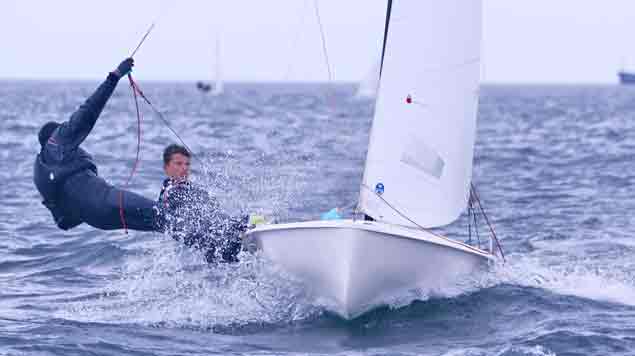 420 leaders Geoff Power James McCann from Waterford Harbour Sailing Club Photo: Simon McIlwaine
420 leaders Geoff Power James McCann from Waterford Harbour Sailing Club Photo: Simon McIlwaine
The Optimist fleet had four races today which tested all of the youngsters especially with a squall at the start of the last race with all but only a few getting too tired in the testing conditions to finish the last race.
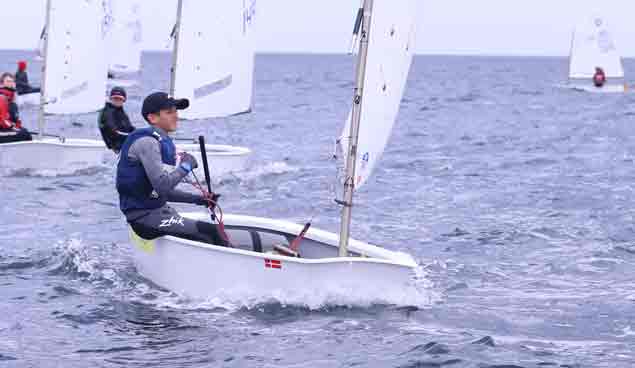 Optimist sailor Justin Lucas. Photo: Simon McIlwaine Photo: Simon McIlwaine
Optimist sailor Justin Lucas. Photo: Simon McIlwaine Photo: Simon McIlwaine
The Laser 4.7 fleet started their racing today with Sally Bell's younger brother Harry from Royal North Ireland winning the first race. Jack Fahy won the second race and Clare Gorman the last but the most consistent and now leads overall with a 4,2,1
 Clare Gorman of the National Yacht Club leads the Laser 4.7s Photo: Simon McIlwaine
Clare Gorman of the National Yacht Club leads the Laser 4.7s Photo: Simon McIlwaine
Another family affair, Jack Fahy's sister Kate showed great form in the Topper fleet which was also racing for their first day lying second overall from East Down's Sarah Jennings. Rob Keal won the first two races however and leads overall with 1,1,4. The Topper 4.2 fleet saw a local fight between Lewis Thompson, Hannah Dadley-Young and Josh McGregor with Lewis also getting 3 bullets for the day.
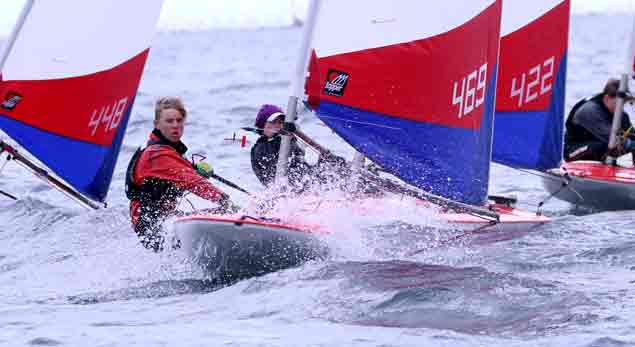 Rob Keal of Royal Cork is the Topper leader Photo: Simon McIlwaine
Rob Keal of Royal Cork is the Topper leader Photo: Simon McIlwaine
Full results are here. Optimist trials results may be found here.
In the evening, Rio Olympic Silver medallist Annalise Murphy gave the young audience some great reflections of her journey from the Optimist Trials through the various Pathway Championships in her Laser Radial and what it took to medal in Rio after the disappointments of London. There were lots of tidbits for the competitors to remember and Annalise revealed the level of commitment required with some of the extracts from her training diary started at the age of 13.
Day 3 of the racing starts tomorrow at 11:00 for all classes. The Championships finish on Sunday.




























